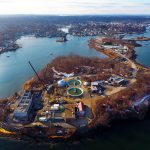This story presented information ahead of the City’s “Wastewater 101” meeting held on September 13, 2023. You can watch a recording of the meeting here:
Following some attention in the local press and on Facebook, Portsmouth’s wastewater system will be the subject of an evening presentation at the library on Wednesday. “Wastewater 101” will provide an opportunity for residents to learn more about the system from City officials.
The event begins at 6:30 p.m. in the Levenson Room.
According to the City’s website, “The purpose of this meeting is to provide an overview of basic wastewater concepts and definitions, the City’s current wastewater system, status of current regulations, system performance, current challenges and upcoming projects.”
This description does not include water and sewer rates as part of the presentation. Portsmouth has the highest water and sewer rates in New Hampshire.
The announcement does not indicate whether attendees will be permitted to ask questions.
Bacteria in South Mill Pond? Facebook Users Want to Know
Not that the questions aren’t there to be asked. Facebook users commented on a September post showing dirty water and a green fuzz on South Mill Pond. Speculations included concerns about cyanobacteria.



Monte Bonahan, Portsmouth’s Director of Communications and Community Engagement, commented on the same Facebook conversation. He said that “collection experts” test the pond regularly and suspect geese as the source of bacteria in the water.
Other users questioned whether the pond was tested regularly, and asked if the results were posted. Bonahan wrote that he must have meant to have said “recently,” instead of regularly.
He wrote that he would double check to see if those results could be posted. (At the time of publication, there was no further response from Bonahan on the conversation.)
An Expensive System – But Why?
If the “Wastewater 101” event permits questions, residents might inquire about the costs of wastewater treatment in Portsmouth. A substantial part of the expense comes from replacing the remaining combined sewer pipes, as this work visibly continues on city streets.
Other costs linger from past decisions.
During the 1980s, greater scrutiny was applied to Portsmouth’s handling of its wastewater. For years, regulators took a lax approach to the problem, accepting a tenet that said the river adequately diluted the wastewater dumped into it.
When the state insisted that the City clean up its act, City leadership resisted, citing the costs. A lawsuit brought by the Environmental Protection Agency (EPA) and the Conservation Law Fund (CLF) eventually forced the City to act.
Lawsuits are expensive.
Wastewater treatment plants aren’t cheap, either.
The City could have upgraded its Peirce Island Wastewater Treatment Facility (WWTF) using a technology known as Conventional Activated Sludge. This approach would require an expansion of the site into areas of Peirce Island that were popular for recreation, especially dog walking.
Although dog parks are located nearby, the City yielded to residents who wanted to preserve the walking trails and dog park. The plant upgrade incorporated a new, more expensive technology that allowed the facility to remain within its existing fence line.
This image shows the fence line which limited the expansion of the WWTF

Below, a close-up shows small chlorine contact tanks at Peirce Island WWTF

How much more expensive was that technology? About $50 million more, twice the cost of the conventional-style plant.
Despite this expense, and the City’s separate pledge to become an “eco-municipality,” pollution problems persist.
Our recent coverage of the release of untreated wastewater into South Mill Pond highlighted one source of pollution. Another source is the occasional release of wastewater that has been only partially treated into the Piscataqua River.
The upgraded treatment plant can process up to 22 million gallons per day (MGD). However, the chlorine contact tanks were not enlarged when the upgrade occurred, since the plant had to remain inside its existing fence line.
This means that when “high-flow events” occur, and the plant must process more than 6 MGD, the additional wastewater is released after 7.5 minutes in the chlorine contact tanks. Portsmouth applied for and received a permit from NH DES for this practice, even though NH DES regulations require 15 minutes (Section 715.03).
Despite this limitation, the Peirce Island facility received a NH DES award for “2023 Wastewater Plant of the Year.”
Meanwhile, in Prescott Park this summer, people noticed a foul odor coming from the island.
A July 14th story in Seacoast Online noted that “City officials have received complaints about unusually strong odors coming from the city’s wastewater treatment plant on Peirce Island.” Mayor Deaglan McEachern was quoted in the story, saying that the smelly situation was “very far from ideal, but very far from the expected behavior of the plant.”
The article says that the Mayor visited the park but did not notice the odor. “There was no problem there at all,” he said.
See the following link to the City’s announcement for Wastewater 101. Those wishing to participate on Zoom will be able to sign up there.
Wastewater System 101 Meeting Notice Zoom Registration 2023.09.13.pdf (cityofportsmouth.com)
Source: images 2 and 3, Facebook










